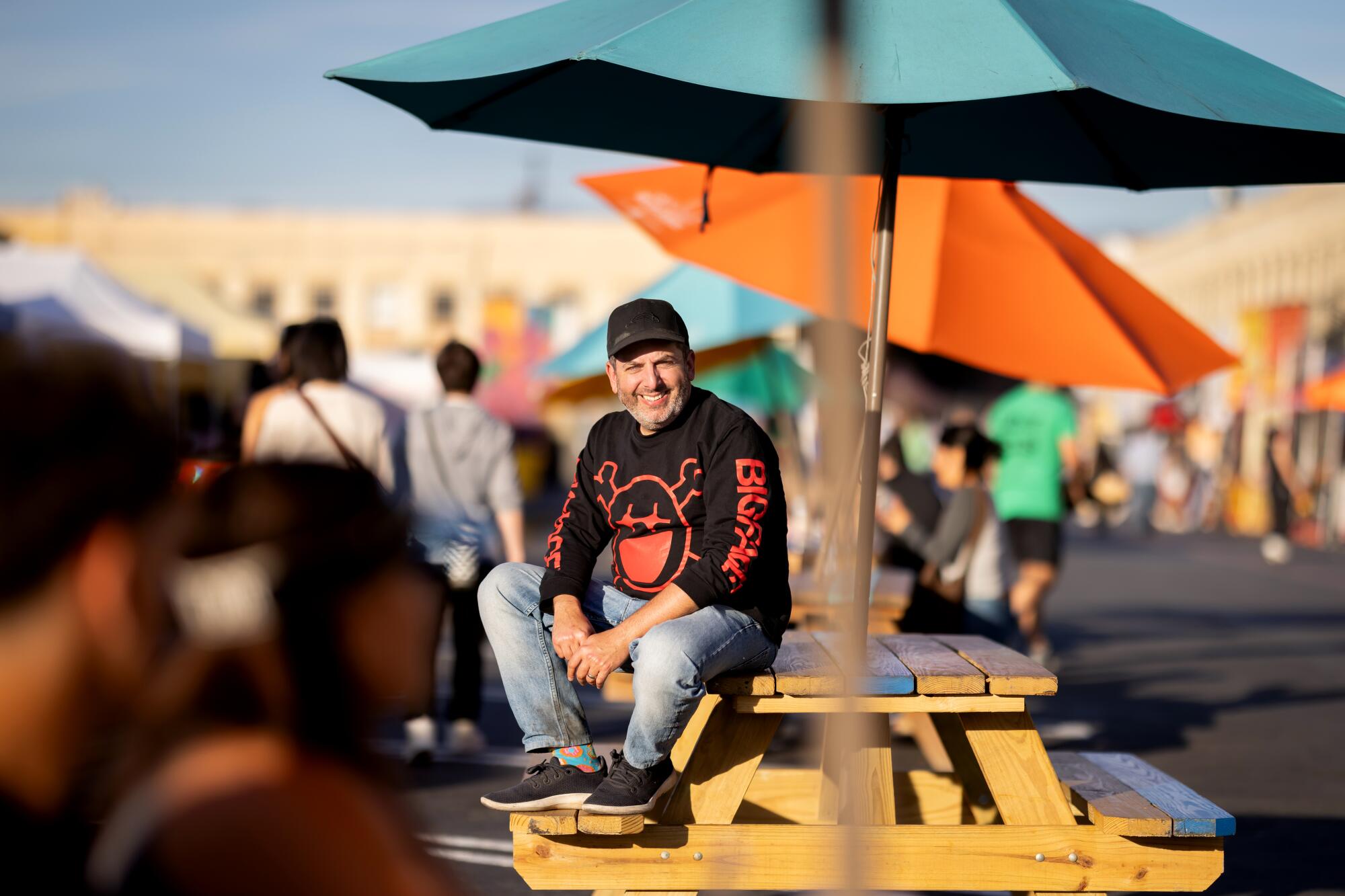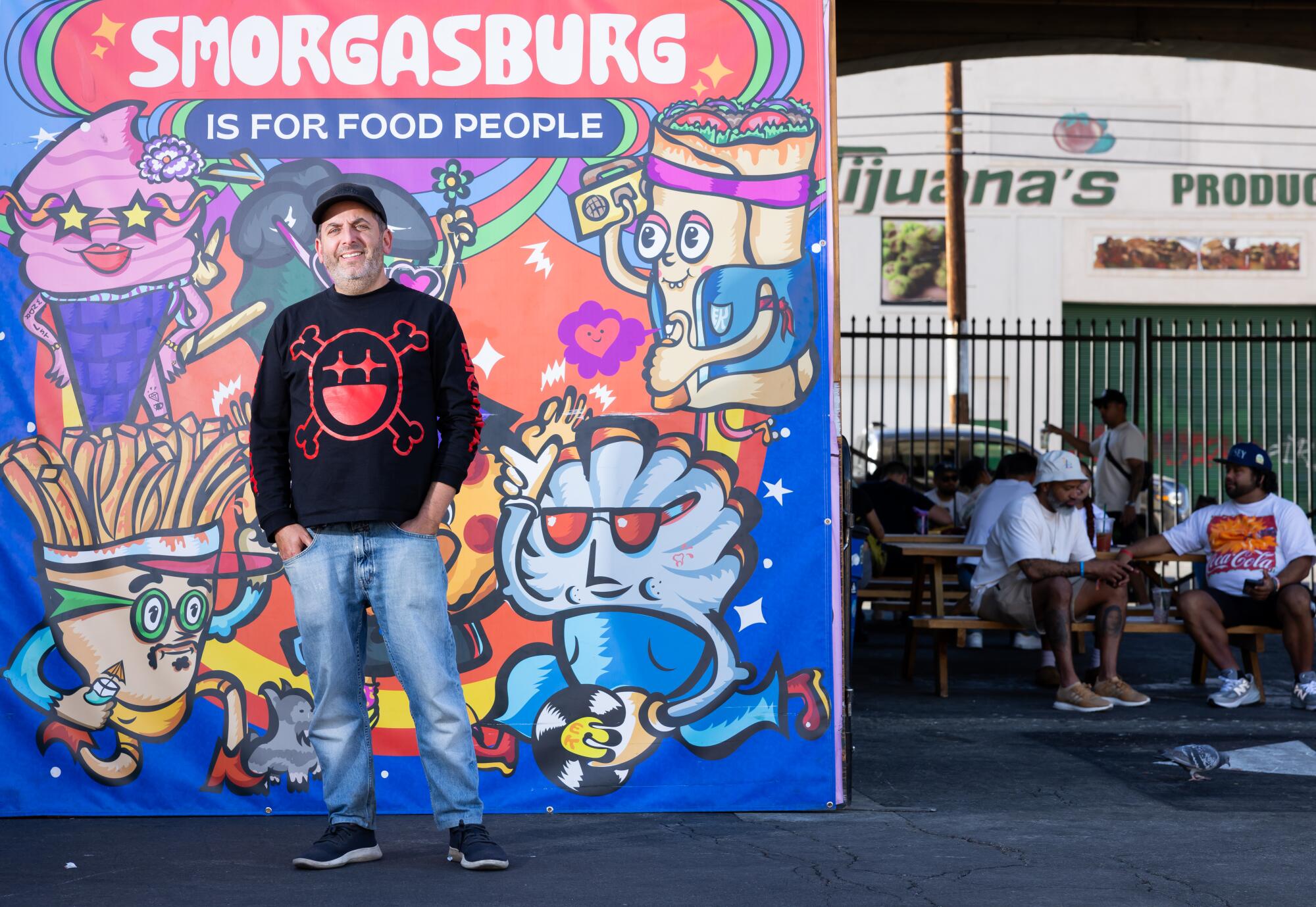
- Share via
“Are you ready? It’s my first-ever double hack.”
Zach Brooks is offering up a paper plate of barbecued lamb hearts with pomegranate sauce and a fluffy, steaming pita he got from the pitmaster at III Mas Barbecue to the dubious cook at Macheen, a pop-up taqueria. It’s 10:30 a.m. at Smorgasburg, the weekly outdoor food market at the Row DTLA, and Brooks, who has been working for more than four hours already, is hungry.
“I’m thinking you take this lamb and put it into your breakfast burrito,” he says with a child’s glee. “Then you take this pita, and you make a Macheen-style sandwich with it. What do you think would be good as the filling?”
Discover the changemakers who are shaping every cultural corner of Los Angeles. L.A. Influential brings you the moguls, politicians, artists and others telling the story of a city constantly in flux.
A few minutes later, Brooks, 48, has his answer, as the Macheen team delivers him the lamb heart breakfast burrito and a fried-chicken-filled pita sandwich. “A full switcheroo!” Brooks exclaims excitedly.
Brooks sidesteps the throngs of people lining up for Cambodian street food from a nearby booth and takes the plate into the mid-morning sunlight. He stacks the burrito and sandwich halves to expose their molten innards, and snaps a quick photo. Then he digs in, bits of tater tot and fried chicken fluttering to the ground below.
Although he describes himself as just a “fat guy who likes to eat,” Brooks is the gatekeeper to a coveted corner of L.A.’s culinary world. As Smorgasburg’s general manager, he decides which of the many fledgling food entrepreneurs clamoring for spots at the Sunday market get to join his hand-picked lineup. An invite from Brooks can provide an invaluable leg up. Time and again, up-and-comers who found their footing at Smorgasburg have gone on to greater things, either opening their own restaurants or finding success in the crowded world of food trucks and pop-ups.
Had it not been for Brooks, Los Angeles may not have discovered the inventive sandwiches at Banh Oui, the Asian-accented ice creams at Wanderlust Creamery or the supremely delicious grilled meats at Tacos 1986, to name a few of the Smorgasburg alums that have graduated to brick-and-mortar locations. And these days, it serves as headquarters for immensely popular vendors such as Lobsterdamus and Chimmelier that have legions of dedicated fans via social media. It also provides real-world experience for newer concepts such as III Mas, which blends Texas-style grilling with Middle Eastern flavors, and Moom Ma’am ice cream, purveyors of wildly creative Thai-inspired gelato flavors. (III Mas recently left Smorgasburg to focus on a forthcoming deli and bakery.)
Time and again, up-and-comers who found their footing at Smorgasburg have gone on to greater things.
“The guy has a dream job — when we applied, he showed up and said, ‘Alright, lemme eat some lobster,’” laughed Lobsterdamus’ Johnny Angeles. “He really believed in us, and gave us a platform to leapfrog into the success we have today. Without [Brooks], I’d be living a totally different life.”
When Smorgasburg’s founders, Eric Demby and Jonathan Butler, were looking to expand west from their first location in Brooklyn, N.Y., they approached Brooks — who founded the influential New York food blog Midtown Lunch before moving to L.A. in 2009 — about running the new show. Brooks was less than enthused.
“I thought it was a terrible idea!” Brooks said. “L.A. is not New York. And downtown is not Brooklyn. And if you expect 20,000 people to wander in off the street, you don’t understand how L.A. works.”

Demby and Butler persisted, persuading Brooks to check out Smorgasburg’s future home — the Alameda Produce Market in L.A.’s Arts District, a part of a larger property that developers planned to transform into the Row, a collection of high-end shops and apartments. After the visit and more meetings, Brooks came around to the idea.
He began working his contacts and approaching chefs he admired. Depth and diversity were key: “My dream was to have a lineup that Jonathan Gold would love,” he said, referring to the late L.A. Times food critic. “But I also wanted stuff that tourists would love, people on Instagram would love, and second-generation Chinese kids from the [San Gabriel Valley] who know what good food is would love.”
He took pains to stand apart. “The last thing we wanted was for people to walk into Smorgasburg and be like, ‘Oh, there are the vendors from our farmers market, there are all the food trucks that park outside of my office on Tuesdays,’” he said. “We knew that when people walked in, they had to feel like they were getting something completely different.”
Brooks seems to have accomplished what he set out to do. After shuttering for 15 months during the COVID-19 pandemic, the market reopened in July 2021 to record-breaking attendance, and today, the 6,000 to 10,000 people who come through the gates each Sunday are treated to the offerings of between 50 and 60 vendors whose food reflects the vast diversity of L.A.’s many immigrant communities. There’s shatteringly crisp, spice-coated Korean fried chicken from Chimmelier; an intimidatingly tentacled pulpo al pastor from Evil Cooks; Hawaiian-inspired treats from Lei’d Cookies (tagline: “cookies so good you’ll feel like you just got lei’d”).
The produce market’s parking lot has room for more booths, and Brooks says the number of applications from prospective new vendors has steadily increased since the pandemic. But he’s hesitant to grow too big: “No one here is raking in cash,” he said. “We add vendors in a way that feels sustainable. Even one vendor might make the difference between another one being profitable or not.”
‘We knew that when people walked in, they had to feel like they were getting something completely different.’
— Zach Brooks
Vendors pay between $150 and $350 each week for their stall and set their own food prices; Smorgasburg does not take a cut of their sales. Though the team is tight-lipped about finances and declined to disclose revenue figures, they do say that the market earns much of its money through its perennially crowded in-house beer garden, run by Fernando Lopez of Guelaguetza and I Love Micheladas, as well as events with brands and community partners such as DineLA, the L.A. Phil and San Pellegrino. There are no leases; vendors are free to leave if they so choose.
Brooks estimates he receives 100 applications a month from people hoping to land a spot at Smorgasburg. He looks for a mixture of passion, business savvy and, of course, great food. It helps if dishes have visual appeal for social media, but it isn’t a requirement; Brooks regularly features vendors on Smorgasburg’s social media channels and has hosted workshops with platforms such as TikTok to help teach participants how to promote themselves.
As with any relationship, timing is key — if the food a prospective vendor wants to serve threatens to cannibalize business from someone already on the roster, chances are they won’t get a spot. But if, say, a very popular ice cream vendor has gone on to open their own place (as was the case with Wanderlust Creamery), Brooks might initiate a weeks-long event such as Ice Cream Alley in part to find a worthy successor (enter Moom Ma’am).
Brooks is emphatic that Smorgasburg does business in a way that is tipped in favor of the vendors. He disdains the arrangements typically offered at food festivals, where organizers take a significant cut of a chef’s sales or expect them to give away their food in exchange for the exposure.
“We can make the amount of money we need to be a successful company without gouging our people,” he said.
This chef-first MO is mildly irritating to his corporate overlords.
“If Zach has an Achilles’ heel, it’s that he’s always taking the vendor’s side,” Demby said. “We have way more people coming now, we could charge more rent, but he says things like, ‘These guys are important to the soul of the market, and if we raise prices, they might leave.’”
Above all, Brooks demands commitment — participants must be at the booth every week, rain or shine — and cautions them that it takes time to build a loyal following, just as it did for the market itself. “Vendors know that this is a partnership — we do a lot for them, and we expect them to respect what we’ve built because it will ultimately help them be successful.”
The tough love belies Brooks’ sharp, self-deprecating sense of humor and the obvious joy he takes at being a cheerleader for his vendors. During the week, between scheduling tastings and scouting for new talent (the market adds new names on a rolling basis), Brooks checks in on his roster of vendors, many of whom are hustling at other pop-ups or festivals, or running their own restaurants. On market days, he’s on-site at 6 a.m., directing load-ins and greeting staff.
‘We can make the amount of money we need to be a successful company without gouging our people.’
— Zach Brooks
He nearly tears up while recounting the origin story of the now-ubiquitous Tacos 1986: “People think they just popped up, but no, what separates those guys is how hard they work. They are killing themselves! They say ‘no’ to nothing to prove that they can be successful at the scale they want.”
Whatever his vendors’ hopes may be, Brooks, as well as Demby and Butler, say they are open to new locations for a potential second market on Saturday, but nothing so far has stuck. “We want Sundays downtown to remain our flagship, and we won’t do anything to dilute that,” Demby said.
For his part, Brooks is happy to remain the man on the ground, walkie-talkie attached to his hip. “Getting into Smorgasburg does have the power to change small business’ lives,” he said. “And if you distill down the process of getting in, yes, that process ends with me. But it’s not really that simple,” he insisted.
“This market is a community, and every single person here got in through a combination of a bunch of different factors, and each vendor has their own story about how that happened,” he said.
As if to prove his point, the walkie-talkie begins to cackle, and Brooks sets his burrito down, heading toward a table where a glass has broken on the asphalt, a minor menace that nonetheless demands his attention. He walks briskly, shaking hands and greeting regulars along the way, before disappearing into the growing crowd.

